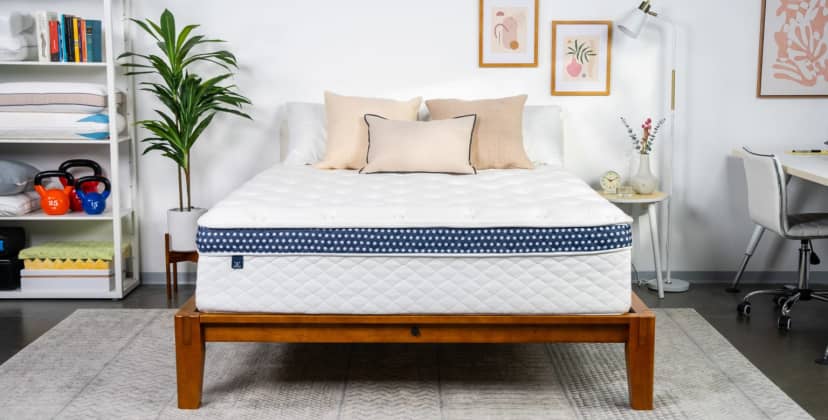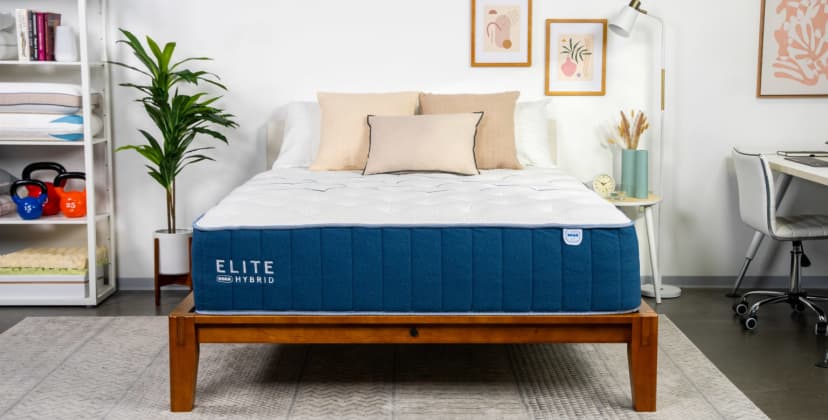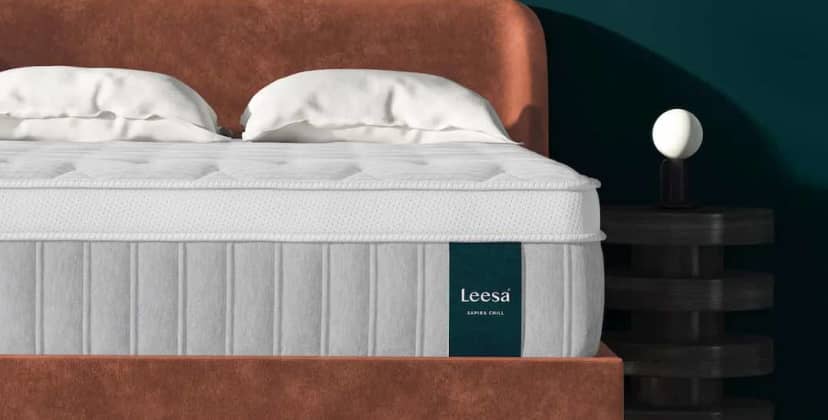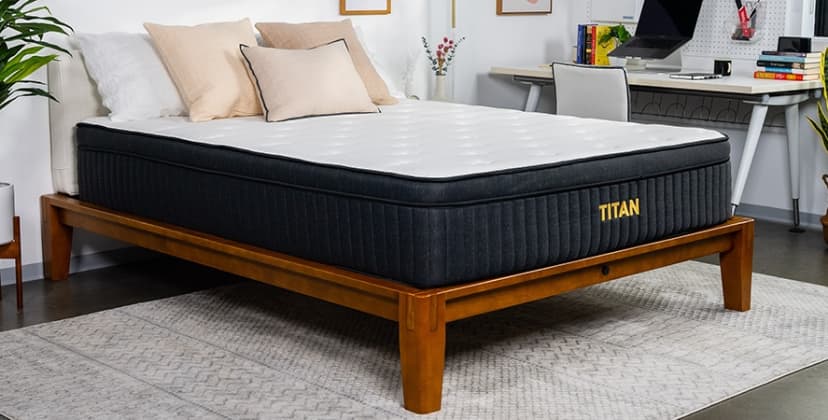When you buy through our links, we may earn a commission. Products or services may be offered by an affiliated entity. Learn more.
Best Mattress for Back Pain
Getting a bad night’s sleep when you already have back pain is like adding insult to injury, affecting not just your mood and energy levels the next day but your mobility and performance at work. In fact, back pain is a leading cause of people missing work in the U.S. If you have back pain — either occasionally, like I do, or chronically, like millions of other Americans — the right mattress can dramatically improve the quality of your sleep.
Over the past decade, our testing team has toiled over nearly 2,000 beds to separate the fluff from the truly supportive when it comes to the best mattress for back pain. In our list of top picks for 2025, you’ll find standouts for pressure relief, zoned support, and balanced comfort across body types and sleeping positions.
Our Top Picks
- Best Overall Mattress – WinkBed
- Best Mattress for Side Sleepers – Helix Midnight Luxe With ErgoAlign
- Best Value Mattress – DreamCloud Classic Hybrid
- Best Mattress for Spinal Alignment – Saatva Rx
- Best Mattress for Lumbar Support – Bear Elite Hybrid
- Best Mattress for Couples – Leesa Sapira Chill Hybrid
- Best Firm Mattress – Plank Firm Luxe
- Best Mattress for Pressure Relief – Brooklyn Bedding Aurora Luxe With Cloud Pillow Top
- Best Mattress for Combination Sleepers – Layla Hybrid
- Best Mattress for Heavy Sleepers – Titan Plus Luxe
In-Depth Reviews
The WinkBed is our top pick for back pain because it hits that sweet spot between sturdy support and real comfort. It’s firm enough to keep my spine aligned, but still feels cushioned. I also love that it holds up over time without sagging or losing its shape.
-
Pros
-
Four firmness options cater to a wide array of sleepers
-
Zoned pocketed coils in support core
-
Foam Euro-top promotes cushioning and pressure relief
-
-
Cons
-
Foam may produce some initial off-gassing
-
Some may find coils too bouncy
-
Mattress Type
Innerspring
Firmness Options
Medium Soft (4), Medium Firm (6), Firm (7), Firm (8)
Price Range
$849 – $1,749
Trial Period
120 nights (30 night requirement)
The WinkBed is a luxury hybrid available in four firmness levels to give you plenty of options for finding that sweet spot between comfort and support.
How It Performed
Testers on our team weighing less than 130 pounds found the medium soft (4) WinkBed most comfortable, particularly the side sleepers. The medium firm (6) design earned high marks from our testers weighing 130 to 230 pounds across all three position groups.
Our back and stomach sleepers weighing 130 pounds or more also found the firm (7) design comfortable, and those over 230 pounds were impressed by the robust support of the WinkBed Plus (8).
Thanks to the zoned coils, the WinkBed scored high marks during our tests for edge support and ease of movement. Most of us could scoot across the surface of the mattress without feeling stuck — a common problem when support is lacking — and the perimeter felt stable as we mimicked movements associated with getting in and out of bed, tying our shoes, and changing positions near the edges.
Construction Breakdown
The medium soft, medium firm, and firm WinkBeds feature adaptive polyfoam quilted into the surface, followed by a layer of denser foam to cushion and reinforce your body. WinkBed Plus models swap out the second foam layer for zoned latex, which is very bouncy and shouldn’t buckle too much beneath your body — even if you weigh more than 230 pounds.
All WinkBeds feature zoned pocketed coils in their support cores. Thicker coils line the perimeter to protect the edges from deep sinkage, and also rest beneath your chest and hips to push back against your extra weight in these areas. A cover made of eucalyptus-derived Tencel fabric encases the entire mattress.
Best Mattress for Side Sleepers
Helix Midnight Luxe With ErgoAlign
20% off sitewide with code: SUMMER20
Shop Now
As a side sleeper who’s dealt with back pain, I found the Helix Midnight Luxe to be a great match. The zoned support really helps keep my spine aligned while giving my hips just the right amount of cushioning. The top layers contour nicely to relieve pressure, especially if you’re somewhere in the mid-weight range like I am.
-
Pros
-
Adaptive foam comfort layers cradle the body and alleviate sore spots
-
Zoned coils provide extra support for the midsection
-
Both cover options excel at cooling
-
-
Cons
-
Foam emits a strong off-gassing odor for the first few nights
-
Back and stomach sleepers over 230 pounds may not receive adequate support
-
Mattress Type
Hybrid
Firmness Options
Medium Firm (6)
Price Range
$1,149 – $2,339
Trial Period
100 nights (30-night requirement)
Many mattresses are suitable for side sleepers, but the Helix Midnight Luxe was specifically designed to accommodate this sleep position. While the target audience weighs 130 to 230 pounds, our testing team found the mattress is comfortable for most sleepers across different weight groups.
How It Performed
Our hands-on tests of the Midnight Luxe revealed the mattress is ideal for side sleepers between 130 and 230 pounds and back sleepers under 130 pounds. That said, the mattress earned favorable ratings from most of our team. The balanced medium firm (6) feel ensures ample cushioning for side sleepers, as well as sturdy support for back and stomach sleepers — though people who use the latter two positions and weigh more than 230 pounds may find the Midnight Luxe too soft.
During our temperature control tests, we found that the Midnight Luxe sleeps fairly cool and doesn’t retain much heat despite the deep foam layers. The Tencel cover gets much of the credit, as this material is known for breathability and moisture-wicking properties. People who are exceptionally warm sleepers should consider the GlacioTex cover upgrade — this fabric is engineered to dissipate heat on contact and feel cool at all times. Other testing areas where the Midnight Luxe performed well include edge support, pressure relief, and motion isolation.
Construction Breakdown
The Midnight Luxe’s Euro-top surface is cushioned with three foam layers, beginning with two layers of memory foam. You’ll notice a light bounce when you get into bed — this comes from the coils — but as your body settles, the foam molds to your figure for a cloud-like cradling effect. Transitional polyfoam provides additional cushioning, but this layer is denser to create some pushback against your weight.
The support core contains pocketed coils over dense base foam. Thicker springs rest below your torso and hips to deliver extra reinforcement for heavier areas of your body. The perimeter coils are also lower-gauge to prevent deep sinkage when you lie or sit along the edges.
Standard Midnight Luxe models include a moisture-wicking Tencel cover. For an added charge, you can upgrade to a cover made of GlacioTex phase change material. You can also add the “ErgoAlign” layer for an extra fee, which consists of dense multi-zoned foam that rests on the surface. This feature is especially helpful for people with severe back pain.
Best Value Mattress
DreamCloud Classic Hybrid
Up to 60% off mattresses + $599 worth of free accessories
Shop Now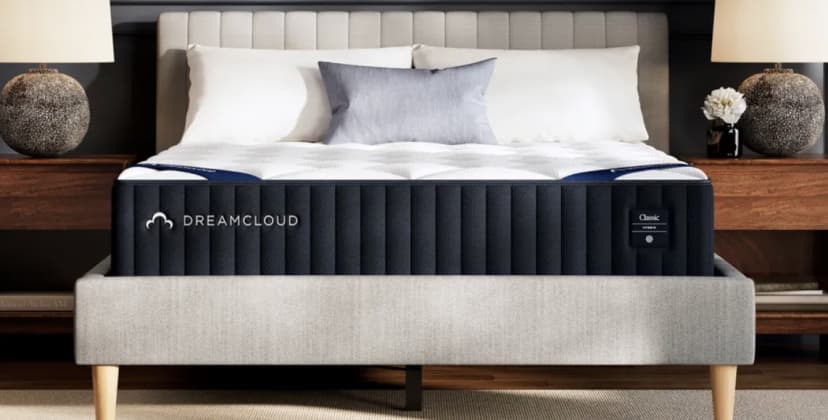
With the DreamCloud Classic Hybrid, I felt like I was getting way more than I paid for. It’s a medium-firm hybrid that offers solid, even support in all the right spots. I’ve dealt with back pain on and off, and this mattress genuinely helped improve my sleep thanks to its pressure relief and overall comfort.
-
Pros
-
Medium-firm feel with a balance of contouring and support
-
Reinforced perimeter coils protect the edges from deep sinkage
-
Competitive pricing and FSA- and HSA-eligible
-
-
Cons
-
Foam layers can emit strong initial off-gassing
-
Stomach sleepers over 230 pounds may prefer a firmer mattress
-
Mattress Type
Hybrid
Firmness Options
Medium Firm (6)
Price Range
$419 – $1,198
Trial Period
365 nights (30-night requirement)
The DreamCloud Classic Hybrid is a luxury hybrid with adaptive comfort layers with a strong support system. A medium firm (6) feel ensures plenty of cushioning for your shoulders, lower back, and hips, but we also found the bed’s thick pocketed coils maintain an even surface and reduce sinkage around the midsection — a common source of aches and pains.
How It Performed
While the Classic Hybrid’s strongest ratings came from our side sleepers between 130 and 230 pounds, the mattress was well received by most of our testers across different body types and sleep positions.
Ample cushioning prevented our side sleepers from feeling sharp pressure points in their shoulders and hips, which often occur for people who use this position. Back sleepers on our team didn’t sink too much despite the thick foam layers.
Temperature control was another high point for the DreamCloud Classic Hybrid during our tests. The above-average cooling comes from both the moisture-wicking cashmere blend cover and steady air circulation through the coil system. Thanks to the thick foam layers, the mattress also performed better than many competing hybrids in testing categories like motion isolation and pressure relief.
Construction Breakdown
The DreamCloud Classic Hybrid begins with memory foam quilted into the cover, followed by an adaptive polyfoam comfort layer. These materials make the mattress invitingly plush when you get into bed, but each layer is progressively denser and you shouldn’t sink too deeply as your body settles. The support core contains pocketed coils with a reinforced perimeter over a high-density foam base. A cover made from a breathable stretch fabric blend encases the mattress.
The Saatva Rx is softer and more adaptive than the average foam hybrid, making it a solid choice for people who appreciate a close hug from their mattress. Foam-tipped coils also help ensure minimal motion transfer and fewer sleep disruptions for couples.
-
Pros
-
Plush, adaptive foam layers hug the body closely to cushion sore spots
-
Foam-topped coils reduce motion transfer for couples
-
All orders include free White Glove delivery and a 365-night sleep trial
-
-
Cons
-
Too soft for most people over 230 pounds
-
Expensive pricing may be a dealbreaker for budget shoppers
-
Mattress Type
Hybrid
Firmness Options
Medium Soft (4)
Price Range
$1,696 – $3,732
Trial Period
365 Nights ($99 Return Fee)
Spinal alignment is key to alleviating back pain, and some mattresses are better at promoting proper alignment than others. The Saatva Rx is a prime example. While this mattress is a hybrid, its medium soft (4) feel and ultra-plush comfort layers ensure deep cushioning and contouring. Back and stomach sleepers may find this mattress too soft, but the majority of side sleepers on our testing team agreed the Rx was exceptionally comfortable and effective at reducing pain and pressure along their spines.
How It Performed
As a medium soft hybrid, the Rx was a big hit among our team’s side sleepers weighing up to 230 pounds, as well as our back and stomach sleepers under 130 pounds. The mattress provides a close body hug, so people over 230 pounds may need more support and pushback from their mattress, but the hugging effect can also be beneficial for those with persistent aches and pains in their shoulders, lower back, and hips.
Motion isolation was one area where the Rx excelled compared to other hybrids we’ve tested. Each coil is topped with a foam cap to absorb movement and isolate motion transfer across the surface, so couples shouldn’t wake each other up when they change positions or get out of bed during the night. By the same token, the mattress sleeps warmer than the average hybrid and edge support is limited at best.
Construction Breakdown
The Rx is constructed with a memory foam lumbar pad quilted to its Euro-top cover, followed by a thick layer of adaptive polyfoam and microcoils for extra cushioning and bounce. Pocketed coils with dense foam caps make up the support core. These coils are intended to provide stability while cutting down on responsiveness and motion transfer. Thicker coils bolster the perimeter, though edge support is still somewhat lacking. An organic cotton cover encases the mattress.
The Rx carries a luxury sticker price, but Saatva sweetens the deal for shoppers with free White Glove delivery. This service includes full setup in your bedroom, and removal of your old mattress and box spring upon request. A generous sleep trial allows you to test the Rx for up to 365 nights before deciding whether to return it for a refund or keep it. If you opt for the latter, your purchase is also covered under a lifetime warranty against manufacturing defects.
The Bear Elite really impressed me with how well it eased pressure on my back. The adaptive foam layers helped minimize those nagging pressure points, and with three firmness options to choose from, it felt like there was something for everyone. I found the medium model especially comfortable for side sleeping.
-
Pros
-
Three firmness options
-
Cooling fabric and steady airflow through the coils help maintain temperature neutrality
-
Memory foam provides strong pressure relief
-
-
Cons
-
Softer models may inhibit some movement across surface
-
Foam may produce initial off-gassing
-
Mattress Type
Hybrid
Firmness Options
Medium (5), Medium Firm (6), Firm (8)
Price Range
$1,231 – $2,548
Trial Period
120 nights (30-night break-in period)
Most of our testers found the Bear Elite Hybrid comfortable thanks to adaptive foam layers that reduce pressure, a supportive coil system, and cooling components that cut down on heat buildup. The mattress is also available in three firmness levels — and if you opt for a split king size, Bear lets you choose a different firmness for each side of the bed.
How It Performed
The medium (5) Elite Hybrid design was most popular among our side and back sleepers weighing up to 230 pounds. This model contours closely to the body for optimal weight distribution, even alignment, and pressure relief along the spine.
If you’re seeking a slightly more supportive build, you should consider the medium firm (6) — this one earned rave reviews from our side sleepers between 130 and 230 pounds and sleepers up to 230 pounds. The firm (8) feel provides light cushioning and robust support, making it most comfortable for testers over 230 pounds.
The Elite Hybrid’s zoned transitional layer maintained an even surface for our bodies and prevented uncomfortable sinkage below the chest, stomach, and hips. Our thermal sensors didn’t detect much heat buildup during temperature control tests, and we noticed a good deal of pushback along the perimeter when testing the mattress for edge support.
Construction Breakdown
All versions of the Elite Hybrid begin with a memory foam comfort layer, followed by transitional polyfoam. The memory foam is infused with copper to help keep the surface nice and cool.
The coils also generate steady circulation throughout the interior, and a cover made of Celliant-blend fabric prevents the mattress from retaining too much heat. The coils are zoned to be thicker and sturdier along the edges, allowing you to sleep along the perimeter and get in and out of bed without sinking.
The Leesa Sapira Chill Hybrid features materials meant to promote even alignment, reduce pressure buildup along the spine, and soothe your sore spots – all while keeping you cool. You can choose from three designs based on your sleep position and body type.
-
Pros
-
Available in three firmness levels to accommodate different sleeper types
-
Above-average motion isolation and pressure relief for a hybrid
-
Zoned coils deliver extra support for the lower back and hips
-
-
Cons
-
Strong off-gassing odor for the first few nights
-
Returns outside the contiguous U.S. incur a $100 fee
-
Mattress Type
Hybrid
Firmness Options
Medium (5), Medium Firm (6), Firm (7)
Price Range
$1,199 – $1,919
Trial Period
100 nights (30 night requirement)
The Sapira Chill Hybrid builds on Leesa’s standard Sapira design with extra elements to help your sleep surface maintain a comfy temperature throughout the night. These include cooling fibers woven into the cover, a gel infusion in the top foam layer, and coils that promote ample airflow throughout the interior.
How It Performed
Our team tested all three of the Sapira Chill Hybrid’s firmness levels, and we found each option is best suited to certain types of sleepers. The medium (4) – or “Plush” – design is a solid match for side sleepers under 130 pounds. If you sleep on your side and weigh 130 pounds or more, or you prefer the back and stomach positions, you’ll probably prefer the balanced medium firm (6) or supportive firm (7) models. These designs sink less and keep your body on a more even plane.
Thanks to the thick foam layers in its comfort system, the Sapira Chill isolates motion very well and alleviates pressure in sensitive areas like the shoulders, lower back, and hips. These qualities are most pronounced on the softer design. With the two firmer models, you’ll get stronger edge support and be able to move across the mattress surface more easily. All three earned high marks for temperature control.
Construction Breakdown
The Sapira Chill Hybrid’s comfort system begins with 2 inches of adaptive, gel-infused polyfoam quilted to the Euro-top cover. Additional polyfoam and memory foam layers provide extra cushioning to create a cradling effect for your entire body. However, excessive sinkage shouldn’t be an issue – the pocketed coils in the support core are zoned to feel sturdier and bouncier beneath your midsection.
Cooling fibers woven into the cover are engineered to capture and release body heat as your skin comes into contact with the mattress surface. At 14 inches tall, the Sapira Hybrid is on the thicker side and you may need to upgrade to a deep-pocket fitted sheet.
I tested the Plank Firm Luxe when I wanted serious support, and it delivered. It’s a flippable mattress with two firm sides, which gave me options to dial in the feel — both were firmer than a lot of beds I’ve tried. If you’re someone who needs that extra support, this one’s worth a look.
-
Pros
-
Flippable design features firm and extra-firm surfaces
-
Optional phase change panel provides exceptional cooling
-
Excellent edge support
-
-
Cons
-
Side sleepers with painful pressure points may need a softer bed
-
Some may find the coils too bouncy
-
Mattress Type
Hybrid
Firmness Options
Firm (7), Extra Firm (9)
Price Range
$693 – $1,299
Trial Period
120 nights (30-night requirement)
The reversible Plank Firm Luxe features a firm (7) feel on one side and an extra firm (9) feel on the other. The latter is one of the firmest surfaces we’ve tested in our lab, and should be suitable for anyone who has found other foam hybrids too soft.
How It Performed
The Plank Firm Luxe earned its most favorable ratings from back and stomach sleepers weighing at least 130 pounds. The majority of our testers preferred the firm side, but a few of us weighing more than 230 pounds appreciated the extra firm surface’s light contouring and robust support.
As is often the case with firmer mattresses, the Plank Firm Luxe performed exceptionally well during our edge support and ease of movement tests. The mattress also sleeps quite cool thanks to consistent airflow through the coil layer. You can opt for a phase change panel on each side if you tend to overheat in bed or sweat in your sleep.
Construction Breakdown
The Plank Firm Luxe’s firm side features a layer of quilting material, followed by latex-like TitanFlex foam and high-density polyfoam. These materials provide a small measure of cushioning without sacrificing firmness or support.
The extra firm side does not contain any TitanFlex and the polyfoam layer is thinner, so this surface conforms very little. A shared support core of pocketed coils rests between the comfort systems.
In addition to the standard model, you can order phase change panels to be sewn into both sleep surfaces. Phase change material is engineered to dissipate body heat on contact and maintain a cool, comfortable surface at all times.
Best Mattress for Pressure Relief
Brooklyn Bedding Aurora Luxe With Cloud Pillow Top
Save 25% sitewide with code: MEMORIAL25
Shop Now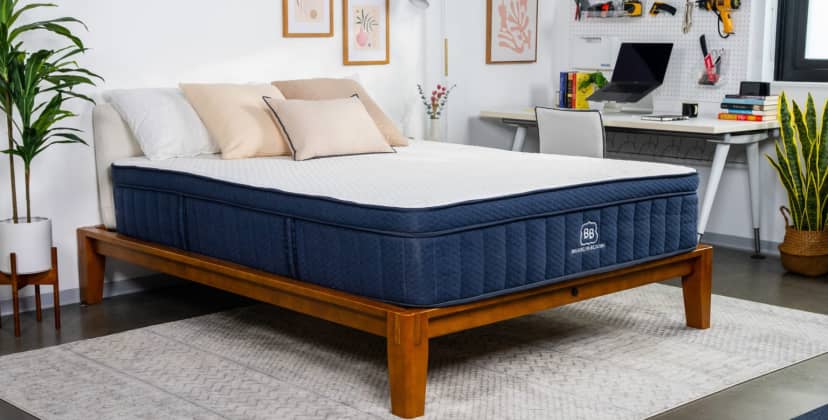
The Brooklyn Bedding Aurora Luxe is an excellent choice for people with back pain due to its cushy, adaptive comfort layers and zoned support system. Adding the Cloud Pillow Top creates even more plushness on the surface, but breathable cover fabric and cooling infusions help ensure minimal heat buildup.
-
Pros
-
Cooling materials help dissipate heat from the surface
-
Three firmness options to accommodate different body types
-
Zoned coils push back against the midsection for sturdy overall support
-
-
Cons
-
Initial off-gassing odor may linger for up to 72 hours
-
Returns incur a $99 fee
-
Mattress Type
Hybrid
Firmness Options
Medium Soft (4), Medium Firm (6), Firm (7)
Price Range
$899 – $2,198
Trial Period
120 nights (30-night requirement)
If you sleep hot and struggle with back pain, the Brooklyn Bedding Aurora Luxe can help you address both issues. This memory foam hybrid contains adaptive comfort layers infused with cooling materials, zoned coils to support your torso and hips, and a cooling cover engineered to prevent heat retention. Adding the optional Cloud Pillow Top results in extra cushioning and temperature regulation – and even with the upgrade fee, the sticker price is still on par with most competing hybrid models.
How It Performed
Our testing team evaluated all three of the Aurora Luxe’s available firmness levels. The medium soft (4) design was most popular among our side and back sleepers under 130 pounds. At the other end of the spectrum, the firm (7) model earned stellar ratings from back and stomach sleepers over 230 pounds. Those seeking a balance of contouring and support should consider the medium firm (6) design – it was the most popular option among our team, especially those weighing 130 to 230 pounds.
We were impressed with the Aurora Luxe during temperature control tests. Unlike many other memory foam hybrids, this model effectively reduces heat buildup with a cover designed to feel cool at all times and infusions of copper and gel in the upper layers. Motion isolation is another major strength. The foam layers are thick enough to absorb movement and prevent it from rippling across the surface, so you shouldn’t disturb your partner with position changes and other movements – and vice versa.
Construction Breakdown
The Aurora Luxe’s comfort system consists of adaptive polyfoam quilted to a Euro-top, followed by additional comfort layers of polyfoam and transitional memory foam. These materials create a cradling, cloud-like surface that contours to your body’s unique curves, promoting even alignment and alleviating pressure points in the process. With the Cloud Pillow Top, you’ll get an additional 2 inches of foam cushioning.
The pocketed coils are divided into three zones, with the thickest springs resting beneath your midsection. This helps ensure sturdy reinforcement for the areas of your body where the most weight is concentrated, so you shouldn’t sink too much – but choosing the right firmness for your body type is still crucial. A cover made of cooling GlacioTex fabric encases the mattress.
Best Mattress for Combination Sleepers
Layla Hybrid
Get an extra $10 off with exclusive code: sleepy10
Shop Now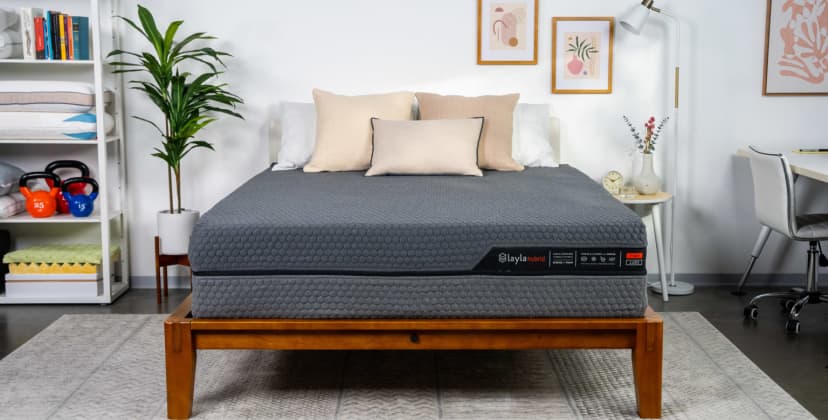
What I love about the Layla Hybrid is its flippable design — it’s like getting two mattresses in one. One side feels soft and plush when I’m craving extra cushion, and the other side gives me more support when my body needs it.
-
Pros
-
Flippable design offers two different firmness options
-
Balance of pressure-relieving memory foam and supportive pocketed coils
-
Airflow through the coils promotes cooling
-
-
Cons
-
Stomach sleepers over 230 pounds may prefer a firmer mattress
-
Foam likely to off-gas upon unboxing
-
Mattress Type
Hybrid
Firmness Options
Reversible: Medium Soft (4), Firm (7)
Price Range
$1,099 – $1,699
Trial Period
120 nights
The Layla Hybrid is flippable with a different firmness level on each side. Our preferred surface varied by tester, but overall we found that this mattress excelled at pressure relief and motion isolation while also sleeping cool and providing adequate support for a wide variety of sleepers.
How It Performed
Our tests show the Layla Hybrid’s medium soft (4) side was best suited to sleepers who weigh less than 130 pounds while the firm (7) side was a better option for sleepers who weigh at least 130 pounds. The coils reinforced the edges and made it easy for our testers to move around on the firm side of the mattress. Although memory foam tends to trap heat, air flows through the coils to help the mattress sleep cool.
Construction Breakdown
The medium soft side has a 2.5-inch copper-infused memory foam comfort layer. The foam contours closely and alleviates pressure in sore spots along your spine, and the copper infusion is meant to keep the surface cool. This layer rests on 2 inches of zoned transitional polyfoam that provides varying amounts of support to different areas of the body.
In contrast, the firm side has a thinner memory foam layer over 1.5 inches of zoned polyfoam — this makes the surface feel much more supportive. The mattress is encased in a breathable cover with vinyl handles on the sides for easier flippability. The shared support core consists of 6-inch pocketed coils.
The Titan Plus Luxe is a foam hybrid geared toward people who weigh more than 230 pounds. Dense comfort layers and strong pocketed coils push back against your body to help maintain a flat, even surface for sleeping, but the foams also contour closely enough to target and alleviate back pain.
-
Pros
-
Ultra-supportive design intended for people who weigh more than 230 pounds
-
Strong edge support ensures you can use the entire mattress surface
-
Optional cooling cover dissipates body heat away from the surface
-
-
Cons
-
Too firm for most people under 130 pounds
-
Strong off-gassing odor for the first few nights after unboxing
-
Mattress Type
Hybrid
Firmness Options
Medium Firm (6)
Price Range
$629 – $1,364
Trial Period
120 nights (30-night requirement, $99 return fee)
The more you weigh, the firmer your mattress should feel. This general rule of thumb helps ensure you won’t sink too much or struggle to move on your sleep surface. The Titan Plus Luxe is a foam hybrid specifically intended for larger bodies, with dense comfort layers and robust coils to keep people over 230 pounds on an even plane. Adaptive foam layers lightly contour to your body to soothe sore spots without sacrificing support or stability.
How It Performed
Our hands-on tests show the Plus Luxe is a versatile option for people with back pain – the foam layers provide enough cushioning to alleviate pressure for side sleepers, while the coils deliver ample support for back and stomach sleepers. The mattress was a hit across most body type and sleep position groups, but earned especially strong ratings from side and back sleepers.
Key strengths of the mattress include sturdy edge support and a responsive surface that’s easy to move on without feeling stuck. The Plus Luxe also sleeps fairly cool, though hot sleepers should consider the GlacioTex cover upgrade. This specialty fabric feels cool to the touch at all times and dissipates body heat as soon as it comes into contact with your skin. Couples should note motion isolation is somewhat limited, and the mattress produces noticeable off-gassing smells for up to 72 hours after you unbox it.
Construction Breakdown
The Plus Luxe features three layers in its comfort system, beginning with 1 inch of gel-infused memory foam quilted into the cover. Denser polyfoam layers provide cushioning and contouring while pushing back against your weight to keep your body aloft. The Titan Luxe is medium firm (6), but you’ll notice more robustness from this mattress compared to many competing hybrids with the same firmness level. Pocketed coils and high-density base foam make up the support core. Standard covers are composed of knit polyester, but you can upgrade to a cooling GlacioTex fabric for an additional fee.
Video: We Tested the Best Mattresses for Back Pain — Here Are Our Favorites
What to Consider When Shopping for a Mattress for Back Pain
Growing up, I heard “Stand up straight!” whenever my parents or teachers caught me slouching. But I’ve learned that good posture is just as important when you’re sleeping. The best mattress for back pain will keep your head, neck, spine, and hips aligned, regardless of your body weight or sleeping position.
That doesn’t necessarily mean you need the firmest mattress possible (unless that’s what works for you), just one that balances spinal support with pressure relief.
“When it comes to back pain, there’s no one-size-fits-all solution,” says one of our medical experts, physician Dustin Cotliar, M.D. “The key is finding a mattress that provides both support and pressure relief in the right areas for your specific needs.”
How you find that Goldilocks mattress depends on how you answer each of the following questions.
Where Do You Have Pain?
Where you feel back pain — whether it’s in your lower, middle, or upper back — can help guide you toward a mattress with the right firmness and support zones to target that specific area.
After plenty of conversations with our medical experts and hands-on testing with our team, we’ve landed on three main things to focus on when shopping for a mattress if you have back pain:
- Pressure Relief: Your mattress should cushion key pressure points. As a side sleeper, that means my hips and shoulders. For back sleepers, it’s the shoulder blades and lower back. And for stomach sleepers, the chest and hips need extra love.
- Firmness Level: While the right firmness level comes down to personal preference, your mattress still needs to support your spine. Even if you love a soft, cloud-like feel, it should be firm enough to keep you aligned. Some research suggests that a medium-firm mattress may help with back pain , though individual needs can differ.
- Zoned Support: Some mattresses I’ve tested offer zoned support, which means they’re designed with varying firmness levels across different areas to provide extra support — like firmer foam under the lower back and softer cushioning around the shoulders and hips. If you’re one of the more than 600 million people with lower back pain, lumbar support is especially important .
What’s Your Sleeping Position?
Your preferred sleep position plays a big role in how your mattress should support your back. “Sleeping position can be an important consideration for people with back pain,” Dr. Cotliar says. “It’s essential to choose a mattress that supports your preferred sleep position while maintaining proper spinal alignment.”
Back Sleeper
A soft mattress is the worst enemy of back sleepers. Trust me, I know from experience. Even if you don’t think you want a mattress with the word “firm” in it, believe me, you want something firm enough to keep you from feeling like you’re sleeping in quicksand. Back sleepers need a mattress that supports the natural curve of the spine, especially in the lower back. And usually, that means a medium-firm mattress.
Side Sleeper
If you sleep on your side (like me and the majority of sleepers), your shoulders and hips press more deeply into the mattress. The best mattress for side sleepers keeps your spine straight, which, again, usually means medium firmness. Too-firm beds can put excess pressure on your hips and shoulders, while too-soft beds may let the hips sink too much, throwing the spine out of alignment.
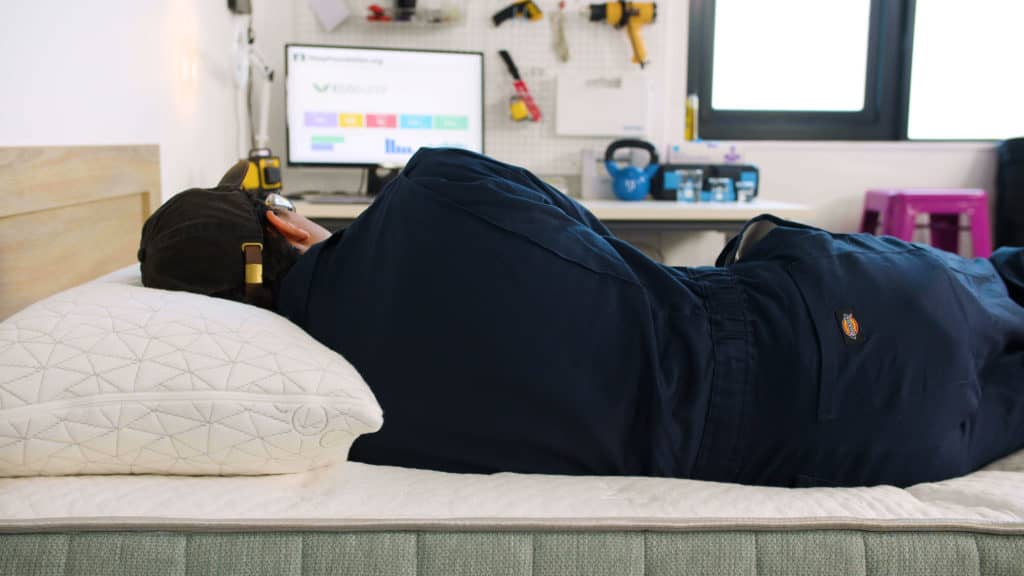
I also sleep with a pillow between my knees to keep my spine and hips in place and take some of the pressure off my shoulder.
Stomach Sleeper
I hate to break it to you, but sleeping on your stomach is generally considered the worst position for your back. If your mattress is too soft, your belly will sink and curve your spine. Plus, keeping your head turned sideways all night really does a number on your neck.
That doesn’t mean you need to train yourself to sleep in a different position (though that’s certainly an option if your back pain doesn’t go away), you just need a mattress firm enough to keep your hips elevated and prevent your midsection from dipping too deeply.
How Much Do You Weigh?
Body weight is another important factor to consider when choosing your mattress, as it plays a huge role in how comfortable a mattress’s firmness level feels. Plus, if your mattress doesn’t properly support your weight, you risk sinking no matter what sleep position.
In general, if you weigh 230 pounds or more, a firm or extra firm mattress will probably help you sleep better. People 130 and under are less prone to sinking and can get by on a softer bed. However, if you have back pain, medium-firm is still a good idea. For reference, I’m 180 pounds, and I sleep most comfortably on a medium firm.
Other Things to Consider
During my search for the perfect mattress, even after I accounted for body weight, sleeping position, and location of my back pain, I was still left with a lot of options. I relied on our testing team’s list of other criteria to help me narrow down my search.
- Ease of Movement: On nights when my back pain is particularly bad, changing positions feels like torture. I’ve found that a responsive innerspring or latex mattress makes switching positions easier, can help reduce strain, and improve comfort.
- Edge Support: Strong edges make it easier to sit or sleep near the perimeter without slipping or sinking — a useful feature if you have back pain and need extra stability getting in and out of bed, like me.
- Quality Materials: High-quality materials provide better support, resist sagging over time, and maintain proper spinal alignment — all key for managing back pain long-term.
- Motion Isolation: I admit this one isn’t directly about back pain, but if you sleep with a restless partner, strong motion isolation helps you stay asleep through their tossing and turning and feel well-rested in the morning.
- Temperature Regulation: If you sleep hot, overheating can disrupt your rest — and quality sleep is essential for managing back pain. A mattress with breathable materials or cooling technology can help you stay comfortable and undisturbed through the night.
What Type of Mattress Is Best for Back Pain?
When I started shopping for a mattress to help with my back pain, I quickly realized there are a lot of options out there — and not all of them are helpful. These are the five most common types of mattresses, along with what each one might mean for your back pain.
Innerspring
What they’re made of: Innerspring mattresses are probably the ones you slept on as a kid. I know I did. They’re composed almost entirely of metal coils, though sometimes there might be a thin layer of cotton, polyester, or foam above the coils.
What they can do for your back: Innerspring coils are responsive, meaning they’ll bounce back to help prevent sinking. They’re also easier to move in case you switch sleeping positions.
Latex
What they’re made of: Latex mattresses are made completely with latex, which is a type of rubber. Most use natural latex from trees, but they can come in synthetic or blended latex.
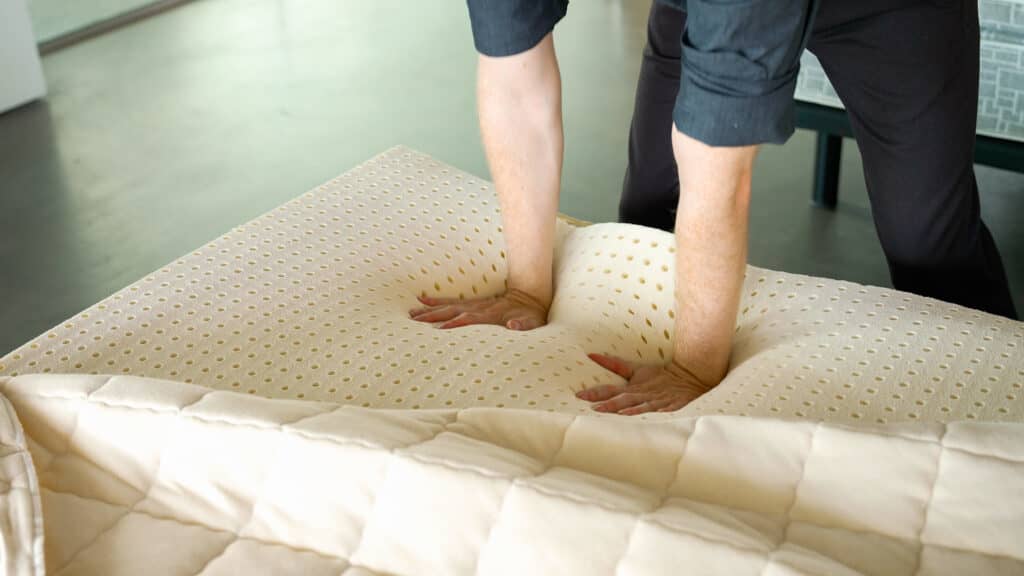
What they can do for your back: Most latex beds we’ve tested have moderate contouring effects, which means they cushion the body but are firm enough to prevent an excessive amount of sink, which is especially good for the lower back.
Memory Foam
What they’re made of: Memory foam mattresses are made from synthetic materials known for their thickness and elasticity. The more dense the foam, the firmer the mattress.
How they can help your back: I’ve found that memory foam mattresses do a great job of holding me in place, keeping me from tossing around and twisting my back, and cushions my shoulders and hips to keep my spine aligned.
Hybrid
What they’re made of: Hybrid mattresses have innersprings coils covered with layers of foam, latex, microcoils, cotton or fiber fill, down, and/or wool.
What they can do for your back: Hybrids combine an innerspring support core and foam layers. They’re soft enough to feel plushy, but supportive enough to relieve pressure on your back, hips, and shoulders. I’ve had the best luck with hybrid mattresses because of this.
Airbeds
What they’re made of: Airbeds use adjustable air chambers for support, often layered with foam, latex, or fabric covers for added comfort. Many models allow you to control mattress firmness levels with a remote or app, and some include dual firmness for couples.
What they can do for your back: The ability to fine-tune firmness makes airbeds a great option for people with back pain. You can adjust the support to your needs on any given night — and some models offer zoned air chambers to better support the lower back and other pressure-sensitive areas.
How a Bad Mattress Can Cause Back Pain
If you’re like me and regularly wake up with back pain that improves as the day goes on, your mattress may be part of the problem. In general, it’s best to avoid these types of mattresses if you’re prone to back pain:
- Overly soft mattresses
- Very firm mattresses without cushioning
- Old or sagging mattresses
- Low-quality foam mattresses
- Innerspring mattresses without a comfort layer
Whenever I’ve crashed with a friend on their sofa bed or saggy guest room mattress, I know I’m going to wake up with back pain. That’s because an overly soft or unsupportive mattress can throw your spine out of alignment while you sleep, putting excess pressure on key areas like your lower back, shoulders, or hips. If your mattress is too soft, your body may sink too deeply, causing your spine to curve unnaturally.
On the flip side, if it’s too firm, it might not provide enough cushioning at your pressure points, leading to stiffness and soreness in the morning. Over time, these nightly imbalances can aggravate existing pain and make it harder for your body to fully rest and recover.

Best Sleep System for Back Pain
Creating the right bedroom setup for my back pain went beyond choosing a mattress — a mattress topper, adjustable bed base, and even the right pillow played a significant role in reducing my back pain and promoting better sleep.
Pillows
The right pillow plays a big role in reducing back pain by supporting healthy spinal alignment from the top down. Your pillow should keep your head, neck, and shoulders aligned with the rest of your spine, depending on your sleeping position.
As a side sleeper, I typically need a thicker, firmer pillow to fill the space between my head and shoulders, while back sleepers benefit from a medium-loft option. Stomach sleepers usually need a soft, low-loft pillow — or none at all — to avoid straining the neck and upper back.
Mattress Topper
My back pain wasn’t going to pause just because I was searching for the perfect mattress. So as a stop-gap measure, I got a mattress topper designed for back pain. It was a simple, cost-effective way to add support or softness to my existing mattress, which was starting to sag a bit. It supported my spinal alignment and reinforced lumbar support.
So if a new mattress isn’t in your budget, look for toppers made with high-quality memory foam or latex for targeted contouring and durability.
Adjustable Bed Base
An adjustable bed base lets you elevate your upper or lower body to reduce pressure on your spine and ease back pain. For example, raising your legs slightly can take pressure off the lower back, while elevating your head can improve alignment and reduce strain.
Adjustable bases are especially helpful for people who struggle to get comfortable lying flat, and many come with features like massage or zero-gravity presets for extra comfort.
Tips for Sleeping With Back Pain
Finding the right mattress and sleep setup was a game-changer for my back pain. But I didn’t stop there. Here are some other things I’ve done to ease discomfort and improve my sleep.
- Stretching or light yoga before bed can help loosen tight muscles and release built-up tension. I’ve found that even a short, relaxed walk gets my blood flowing and helps me wind down.
- Since I’m a side sleeper, I place a pillow between my knees to align my hips and lower spine. Back sleepers can benefit from placing a pillow under the knees, while stomach sleepers (if you really can’t sleep any other way) may feel more supported with a thin pillow under the hips to prevent over-arching of the lower back.
- When I’m not testing mattresses, I’m spending all day at my desk, so I make sure I’m practicing good posture throughout the day.
- A dark, quiet, and cool bedroom can help promote deeper, restorative sleep. I use blackout curtains, and other members of our testing team swear by a white noise machine or a fan to reduce outside distractions.
- A warm bath, heating pad, or warm compress can help relax tense muscles, while a cold pack may help reduce inflammation if your pain is more acute.
- Talk to your doctor about underlying conditions and recommended therapies or medications that support both pain management and quality rest.
How We Test: Your Comfort Is Our Science
When we test mattresses, we’re not just flopping down on them for a couple of minutes to see how they feel. In our Seattle-based Test Lab, we use an objective, hands-on process to evaluate mattresses, and we’ve used that process to test over 2,000 mattresses in the last decade.
Our industry-leading product testing team cares deeply about improving your sleep. Since a bed’s comfort and feel depend largely on body weight and sleeping position, our team represents a wide range of body types, sleep positions, and comfort preferences.
During our testing, we draw on multiple sources of information that each enhance our overall perspective.
Construction analysis: Our ratings system is grounded in mattress design and construction. We look at how each layer of a mattress contributes to its overall feel and performance, and we account for special features like cooling technology.
Quantitative product testing: During in-lab testing, our team uses multiple tools and technologies to measure a bed’s performance in categories like motion isolation, pressure relief, and temperature regulation. We use the outcomes from these tests to calculate a score for each category.
Field testing: Our field testers (such as yours truly) sleep on mattresses in their own bedrooms. After weeks of at-home testing, each field tester provides a detailed analysis of how the mattress performed in a real-world setting.
User feedback: Beyond our team, we draw insight from surveys and verified customer reviews to identify problem areas, fine-tune our ratings, and better understand how each product performs over time.
How We Determine Our Overall Scores

When you look at our mattress reviews, you’ll see ratings for six key categories. Not every performance category is equally important to your overall satisfaction with a mattress, so we give some categories greater weight when determining an overall score. Here’s a quick breakdown of the categories and why they’re important.
Performance Categories
Motion Isolation
This is how much vibration a mattress absorbs when someone moves on its surface. We measure this with a vibrometer, and the results help determine whether you’ll be woken up when your bed partner rolls over or gets in or out of bed.
Temperature Control
No one wants to wake up clammy and hot, so we perform temperature tests with a heat gun to see how much a mattress heats up and how quickly it dissipates any built-up heat.
Pressure Relief
In this guide, I’ve already covered why pressure relief is important for people with back pain. We use pressure mapping technology that shows just how much impact occurs around the heavier parts of the body.
Edge Support
Mattresses with strong edge support provide a more dependable and reliable sleep surface. We perform tests measuring how much the edges sink when you sit or lie down near the perimeter and how long it takes for the edge to return to its original shape.
Ease of Movement
This category reflects how easy it is to move on the bed’s surface. Materials like latex tend to get higher scores for ease of movement. As with testing edge support, we use kettlebells to determine how deeply a mattress compresses and how quickly it bounces back.
Off-Gassing
A mattress that has been compressed to ship in a box can release unpleasant chemical odors due to volatile organic compounds (VOCs). Though they’re not harmful, they can be annoying, so we analyze how strong the smell is and how long it takes to fade away.
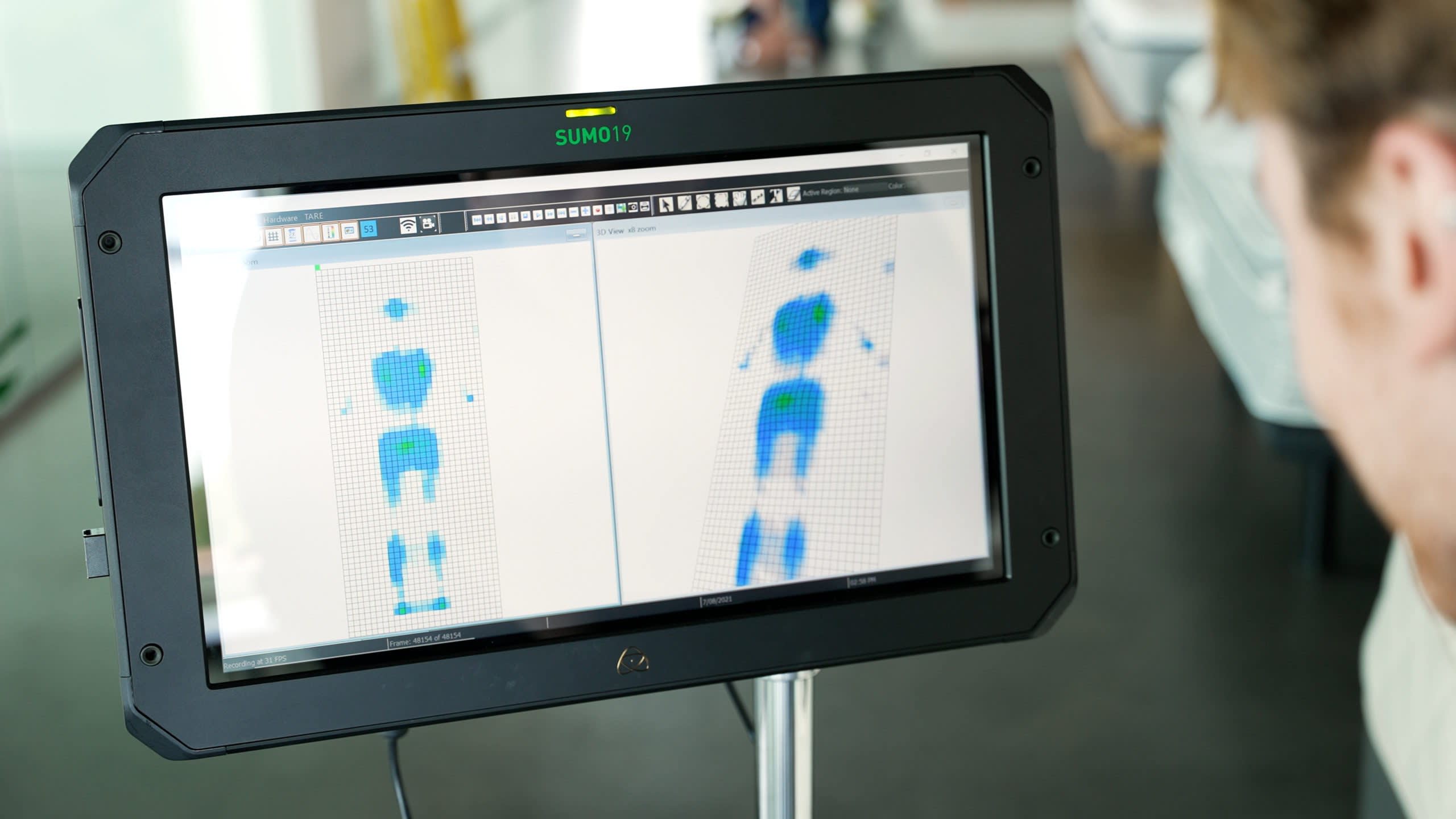
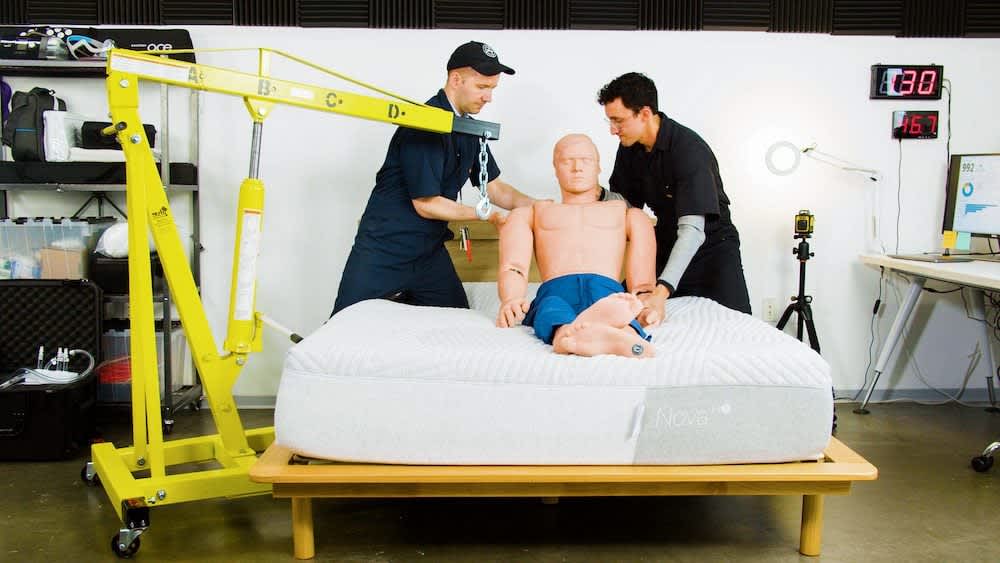

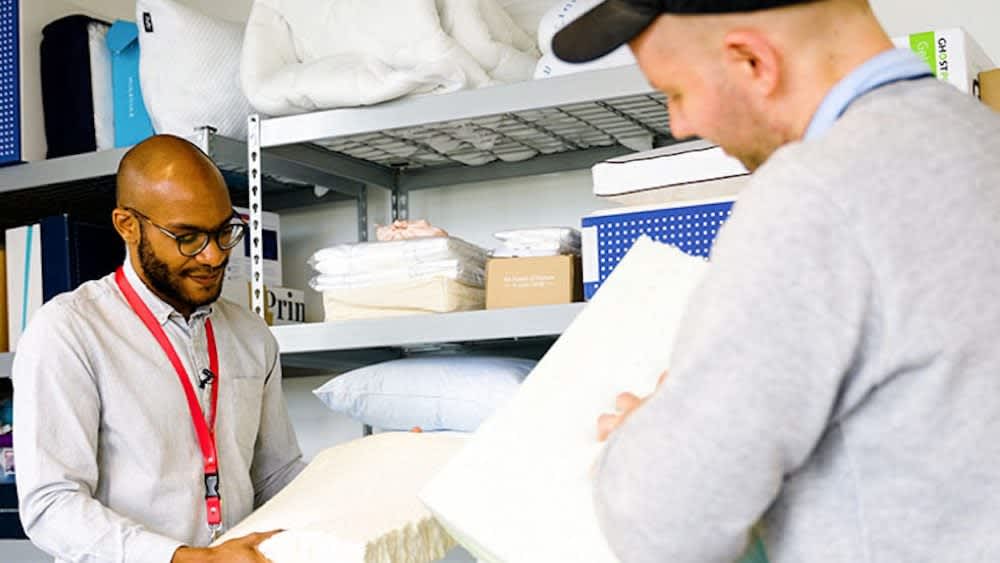
More Mattress Guides
Still haven’t found your perfect mattress? For more help deciding which mattress is right for your specific needs, check out the guides below.
Best Mattress by Specific Purpose

Still have questions? Ask our community!
Join our Sleep Care Community — a trusted hub of product specialists, sleep health professionals, and people just like you. Whether you’re searching for the perfect mattress or need expert sleep advice, we’ve got you covered. Get personalized guidance from the experts who know sleep best.
References
3 Sources
-
“Chronic Back Pain – Health Policy Institute.” Health Policy Institute, 13 Feb. 2019.
https://hpi.georgetown.edu/backpain/ -
Caggiari G, Talesa GR, Toro G, Jannelli E, Monteleone G, Puddu L. What type of mattress should be chosen to avoid back pain and improve sleep quality? Review of the literature. J Orthop Traumatol. 2021;22(1):51. Published 2021 Dec 8. doi:10.1186/s10195-021-00616-5
https://pmc.ncbi.nlm.nih.gov/articles/PMC8655046/ -
GBD 2021 Low Back Pain Collaborators. Global, regional, and national burden of low back pain, 1990-2020, its attributable risk factors, and projections to 2050: a systematic analysis of the Global Burden of Disease Study 2021. Lancet Rheumatol. 2023;5(6):e316-e329. Published 2023 May 22. doi:10.1016/S2665-9913(23)00098-X
https://pubmed.ncbi.nlm.nih.gov/37273833/


